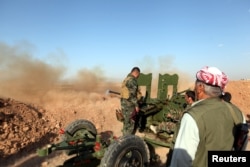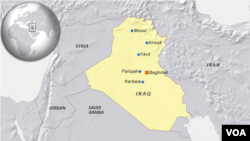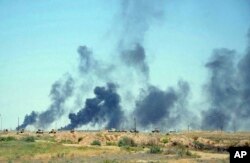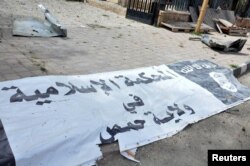For the United States and its coalition partners, it is the sound of progress – the dull roar of engines as Iraqi Humvees kick up dust and dirt on the outskirts of Fallujah. In the distance, smoke rises as Iraqi forces push on with a slow but steady advance.
The scene, shared in a video handout by the Iraqi Ministry of Defense, makes the battle for the key city look more methodical than it is. Closer in, Iraqi forces are meeting with what coalition officials have described as “stiff resistance” from Islamic State (IS) fighters.
But for many, the trend appears clear: The terror group’s self-declared caliphate is starting to crumble.
“This is the first time ISIL is experiencing pressure from a number of places,” said a U.S. official who spoke to VOA on condition of anonymity, using an acronym for the group.
“We’ve never seen them have to react to this sort of pressure,” the official added. “We’re looking closely.”
Possible death spiral?
So far, the results have been less than impressive for IS fighters forced to confront Iraqi, Kurdish and Syrian forces backed with U.S. and coalition air power.
“ISIL is unable to respond,” said a U.S. intelligence official, describing the group’s attempts at resistance as a “lashing out.”
“ISIL has ramped up its use of suicide attacks, particularly against Shia religious pilgrims, to foster sectarian discord, disrupt government functions and deflect attention from its inability to recapture and hold territory,” the official said.
Increasingly, the terror group’s fighters have retreated back to a dwindling number of strongholds like Fallujah in Iraq and Manbij in Syria.
“We could be looking at a death spiral that will destroy the organization,” said Daveed Gartenstein-Ross, a senior fellow at the Foundation for Defense of Democracies who has been closely following IS’s fortunes.
For almost two months, U.S. intelligence officials have described IS as being “at its weakest point since its rapid expansion,” pointing to a number of factors.
IS cash flow, while still significant, has been cut substantially, with U.S. Treasury Department officials noting the group’s profit from oil sales has been cut in half.
The flow of foreign fighters, at one time flocking to the group at a rate of 1,000 or more a month, has slowed to a trickle. No longer able to replenish fighters at the rate they are being lost on the battlefield, U.S. military officials say IS leaders in places like Manbij are turning to forced conscription of captive civilian populations.
“I don’t think they can reverse their losses in Iraq, Syria or in Libya,” Gartenstein-Ross said, warning IS’s grip on its self-declared wilayats, or provinces, is also tenuous.
“In almost every theater, its foreign presence, where it has expanded outside of Iraq and Syria, has been massively overstated, including in Yemen, including in Somalia, including in Algeria and elsewhere,” he said.
Capable of surviving
Still, U.S. officials have been cautious, continuing to describe even a faltering IS as a “dynamic and formidable threat” that still holds key territory, including the city of Mosul, Iraq and its capital of Raqqa in Syria.
“I actually see the overall strategic environment as favoring ISIS’ retention of those cities,” said Jessica McFate, a former U.S. Army intelligence officer who served in Iraq, using yet another of the group’s acronyms.
“The major impediment to that operation is not ISIS’ capability to defend but the inability of anti-ISIS elements on the ground in Syria to get along well enough to be driving in the same direction,” she said.
Ultimately though, McFate, now with the Institute for the Study of War, agrees that, IS is going to lose most of its terrain. But she remains concerned that the terrorist group still has the ability to survive, noting the durability of its predecessor, al-Qaida in Iraq.
“ISIS has latent capability to regenerate operations again,” she said.
That capability also worries senior U.S. officials, who have called the “scourge” of IS a long-term challenge that goes well beyond smashing the self-declared caliphate.
“It’s a mistake just to focus on the [IS] state in Syria and Iraq,” Middle East Forum President Daniel Pipes told VOA via Skype, saying the group’s aggressive strategy has given it too many enemies to retain control of any meaningful terrain.
“But that doesn’t mean the end of ISIS as an idea, an ideal, as an inspiration and as a force around the world,” he said. “ISIS found a way to inspire violence throughout the west, not just in the West in the Muslim world as well that is powerful and presumably enduring.”
More terrorism coming
U.S. military and intelligence officials hope that, at the least, the eventual demise of the caliphate will strike a significant blow, doing irreparable damage to an IS brand deeply rooted in the idea of a caliphate and built on the notion of unceasing military momentum.
Yet even with IS forces reeling in Iraq, Syria and Libya, a U.S. official cautioned the terror group “maintains the means to wage its brand of violence.”
And it could get worse before it gets better.
“We should be prepared for an increase in terrorism in the region and in the West,” said J.M. Berger, a fellow at George Washington University’s Program on Extremism.
“If the proto-state falls, those resources will be available for terrorism,” he added. “Terrorism is much less resource-intensive than governing – even a small insurgency translates into a very large terrorist organization.”





